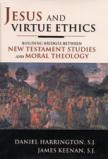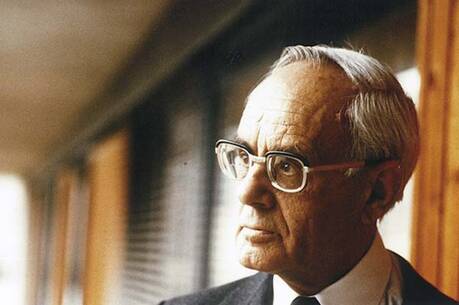Building Bridges
Although Vatican II urged moral theologians to pay attention to Scripture and the Christian vocation, the old wineskins of traditional moral theology burst under the ferment of new biblical, personalist and liberationist contents. Connecting Scripture and moral theology has proven to be a formidable task, but the authors have taken a novel and largely successful approach in this volume.
The New Testament scholar Daniel J. Harrington, S.J., and the moral theologian James F. Keenan, S.J., are professors at the Weston Jesuit School of Theology in Cambridge, Mass. As a team, the two are highly qualified for the task of building bridges between the two disciplines. As editor of New Testament Abstracts and author of America’s annual Books on the Bible, Harrington has reviewed almost every book on the New Testament for the past three decades. Keenan is a prolific writer of the next generation, who publishes and edits scholarly and more general works in moral theology.
It would seem that Christian ethicists and biblical scholars would be natural allies. Both are concerned about how to live wisely and graciously in response to God. Presumably, both groups gain inspiration and direction from the biblical text. Too often, however, professional preparation and specialization have left them on different intellectual islands, uncertain about the foreign language and customs of the other discipline. Hermeneutics seems as alien to moralists as Aramaic, while endless debates over dissent and proportionalism must have made biblical scholars grateful that the shadow of official suspicion fell somewhere else.
Most scholarly efforts to bridge the chasm build out from one side, with lopsided results. They either discuss the ethics in various biblical works or the way that biblical materials should be used in doing Christian ethics. Since life is too short for ordinary mortals to master both disciplines, why not dialogue from either side of the divide? The authors’ collaboration in jointly taught graduate courses sets the approach of this volume. In each chapter Harrington discusses the text and context of a specific passage from the Synoptic Gospels with reference to larger biblical themes, while Keenan writes on implications for the moral life with particular reference to the virtues involved. This allows them to bring about a unique fusion of horizons that merges the ethics in the New Testament with a way to use the New Testament in ethical reflection and argument.
The authors selected the ethics of virtue and character as the blueprint for their project. Virtue ethics asks three interrelated questions: Who are we? Who ought we to become? And how do we get there? The traditional rule-centered moral theology asked a much more narrow question: What ought I to do? This was inadequate, because New Testament Christian discipleship calls for transformation of the person, not merely of behavior. Set in the context of the life of Jesus and early Christian communities, virtue ethics provides bridges between moral theology and a variety of other fields, such as spirituality, worship, church life, and Scripture. Most important, it connects theologians and pastors and their communities as they try to respond to the call of Christ. Virtues are normative for who we are to become as well as for how we ought to live.
The major part of Jesus and Virtue Ethics addresses a whole range of traditional topics: love, sin, politics, sex, marriage and divorce. It also ventures into current issues that receive scant treatment in the New Testament: celibacy, homosexuality, abortion and the natural environment. Although the treatments are necessarily brief, they are almost always insightful. Both authors draw on the best of recent scholarship without getting bogged down in technicality. By providing judicious bibliographies on each topic, study questions and a glossary of terms, they make this text attractive to university and graduate-level teachers as well as an educated laity.
Harrington’s careful location of the specific passages within the theological and literary context of the particular Gospel counteracts the tendency to consider them in isolation. Especially insightful is Keenan’s treatment of sin as the failure to bother to love. Few figures in the New Testament ever recognize their sinfulness. He also commends a contemporary set of cardinal virtues: justice, fidelity, self-care and prudence. He moves closer to the cutting edge in arguing that the New Testament would have us respect all human life as sacred and inviolable, not only innocent life. This extension has implications for war, welfare and capital punishment that more limited versions of a consistent ethic of life have been unable to argue persuasively. His measured treatment of homosexuality as a not unnatural manifestation of human loving reflects an emerging consensus in society and in many Christian churches. He agrees with a number of Protestant ethicists and biblical scholars that it is doubtful that Paul recognized that some persons were constituted in their nature as homosexual, which makes the Pauline condemnations less universal than has commonly been understood.
Readers of this book will envy the students who took part in the authors’ team-taught seminars. That context would have provided more opportunity for interaction than the structure of this book allows. Although each scholar speaks in a clear, direct voice that respects the reader, one misses the lively interaction and probing questions that would be possible in a seminar setting. At times the presentations move on tracks that are more parallel than converging. The topics guided the selection of the individual texts, thus forfeiting some of the drama and richness of the emerging narrative of Mark, Matthew and Luke. Every bit of the Gospels was composed in light of the end of the story of Jesus, the stunning event of the crucifixion and resurrection that confers a unique authority on each pericope. The relative isolation of the texts and the lack of a single theological literary vision in this work should be remedied in the authors’ second volume on Pauline ethics and moral theology, which will be published soon.
Harrington and Keenan are modest about their new approach, offering it not as a definitive statement, but as a heuristic that offers a variety of tools to further the project of developing a more biblically based moral theology. Let us hope that their work encourages other scholars to contribute to spanning the academic divide between Scripture and the moral life.
This article also appeared in print, under the headline “Building Bridges,” in the September 8, 2003, issue.








